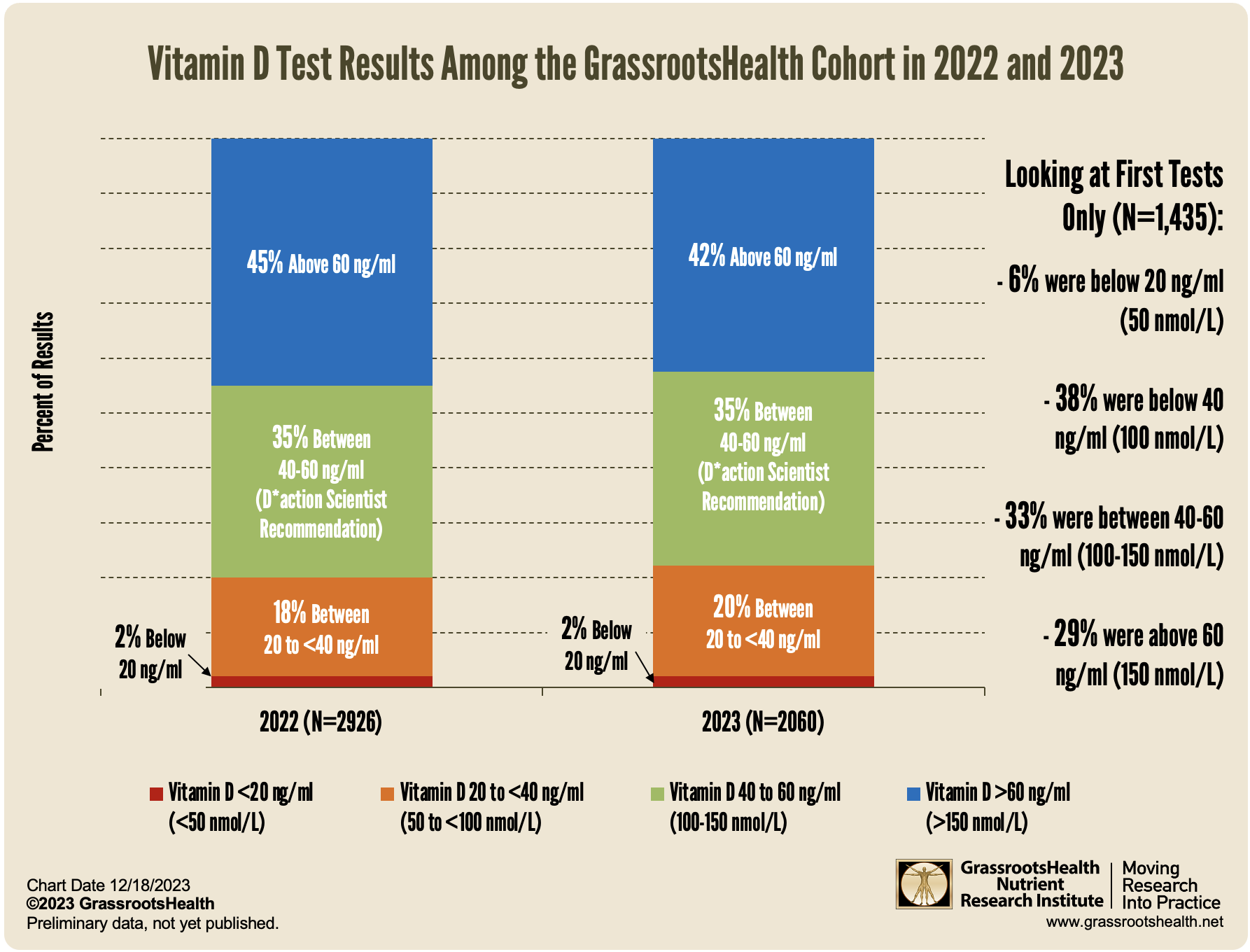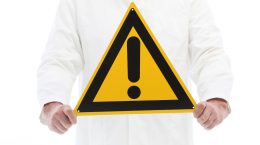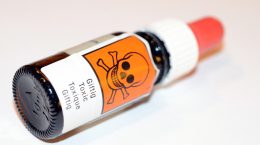Published on December 30, 2023
The average vitamin D result has remained steady at around 60 ng/ml since 2021. What is your level? What is too high, and when is toxicity a concern?
Key Points
- The results distribution from over the last three years among the GrassrootsHealth cohort has remained steady, with an average result of 60 ng/ml (150 nmol/L)
- Looking at first-time vitamin D test results only, for 2022 and 2023 combined, 38% of the vitamin D results were below 40 ng/ml and 29% were above 60 ng/ml, with an average result of 51 ng/ml (127 nmol/L)
- Recent evidence of non-calcemic actions of vitamin D suggests additional health benefits of achieving and maintaining vitamin D levels between 60 and 80 ng/ml (150-200 nmol/L), which could be especially beneficial for reduction of the risks of cancer, multiple sclerosis, some autoimmune diseases, and all-cause mortality
- Levels in excess of 150 ng/ml may raise the concern for vitamin D toxicity, however, vitamin D toxicity is one of the rarest medical conditions, with a meta-analysis showing no toxicity below a vitamin D level of 200 ng/ml (500 nmol/L) or below a vitamin D intake of 30,000 IU/day
 Thank you and congratulations to all of our Citizen Scientists who have contributed their data to the vitamin D*action study and taken steps to improve their vitamin D level, and their health!
Thank you and congratulations to all of our Citizen Scientists who have contributed their data to the vitamin D*action study and taken steps to improve their vitamin D level, and their health!
A preliminary analysis of the GrassrootsHealth data from 2022 and 2023 (through the middle of December, 2023) shows that
- in 2022, 20% of the vitamin D results were below 40 ng/ml (100 nmol/L), and 45% were above 60 ng/ml (150 nmol/L), with an average result of 61 ng/ml (152 nmol/L)
- in 2023 (for results posted through mid-December), 22% of the vitamin D results were below 40 ng/ml and 42% were above 60 ng/ml, with an average result of 59 ng/ml (147 nmol/L)
- looking at first-time vitamin D test results only, for 2022 and 2023 combined, 38% of the vitamin D results were below 40 ng/ml and 29% were above 60 ng/ml, with an average result of 51 ng/ml (127 nmol/L)
Vitamin D Levels Increased from 2020 to 2021, and have Held Steady Since
Our last look at vitamin D results showed a 10% increase in the number of results over 60 ng/ml from the year 2020 to 2021 (going from 34% to 44%), with 9% fewer results below 40 ng/ml (29% versus 20%). The average vitamin D level jumped from 54 ng/ml (135 nmol/L) in 2020 to 61 ng/ml (152 nmol/L) in 2021. This shows that the results distribution from over the last three years among the GrassrootsHealth cohort has remained steady, with an average result of 60 ng/ml.
Are Vitamin D Levels Above 60 ng/ml Safe?
We frequently receive questions from participants about whether a vitamin D result above the scientists’ recommended range of 40-60 ng/ml (100-150 nmol/L) is too high. This recommended range is for general health and is based on overwhelming evidence about the association between vitamin D and the reduced risk of many diseases including bone diseases (rickets, osteomalacia, and osteoporosis), multiple sclerosis, diabetes, cancer, and many others.
In fact, vitamin D levels above 60 ng/ml can provide additional benefits. Recent evidence of non-calcemic actions of vitamin D suggests additional health benefits of achieving and maintaining vitamin D levels between 60 and 80 ng/ml, which could be especially beneficial for reduction of the risks of cancer, multiple sclerosis, some autoimmune diseases, and all-cause mortality. GrassrootsHealth considers levels between 60 and 100 ng/ml (150-250 nmol/L) to be safe and in the high end of a normal range.
When Could Vitamin D Toxicity be a Concern?
We do not currently have data to support any additional health benefit of having a vitamin D level above 100 ng/ml. Levels in excess of 150 ng/ml raise the concern for vitamin D toxicity which is most frequently diagnosed when levels are over 200 ng/ml (500 nmol/L), though not everyone who reaches that level experiences toxicity.
Vitamin D toxicity occurs when high vitamin D levels (typically, over 200 ng/ml) cause high calcium levels, called hypercalcemia. Symptoms of hypercalcemia include loss of appetite, feeling very thirsty, weight loss, constipation or diarrhea, abdominal pain, musculoskeletal pain, or feeling sick, confused, or tired.
A recent interview with Prof. Sunil Wimalawansa elaborates on the safety of vitamin D, when caution should be advised, and avoiding adverse effects, including types of individuals who may need to be more cautious about taking higher doses and concerns about co-nutrients.
According to a Mayo Clinic publication, “There is enough evidence that vitamin D toxicity is one of the rarest medical conditions and is typically due to intentional or inadvertent intake of extremely high doses of vitamin D (usually in the range of >50,000 – 100,000 IU/day for months to years) without monitoring for hypercalcemia.” In fact, a meta-analysis of 15 clinical trials found no toxicity below a vitamin D level of 200 ng/ml (500 nmol/L) or below a vitamin D intake of 30,000 IU/day.
What if a Lower Vitamin D Level is Desired?
Even if your level is not in the toxic range, it may be higher than you want it to be. If you would like to decrease your vitamin D levels, vitamin D input must be reduced. Most often that will mean cutting back on your dose of supplemental vitamin D, and possibly your sun exposure as well. However, before doing this, consider whether a recent change in intake, such as an extra-large dose during a sickness or a recent vacation to a sunny location, may have caused a temporary high level. If your intake has been consistent, reducing your dose by 25-50% may help, followed by a re-test after about 3 to 6 months to assess your response to the lowered dose. (It is very important to test again because you may have overcorrected and caused your levels to be lower than you want). Keep in mind that it may take at least 2-3 months for the vitamin D level to fully respond to the new intake.
Test to See if You Are Getting Enough (or Too Much) Vitamin D and Other Important Nutrients
 Create your custom home test kit to measure your levels at home as part of the D*action project!
Create your custom home test kit to measure your levels at home as part of the D*action project!
With your kit you can measure your:
- Vitamin D
- Magnesium PLUS Essential and Toxic Elements
- Omega-3 Fatty Acids
- hsCRP
- HbA1c
- TSH
- Type 1 Diabetes Autoantibodies
Did you know that each of the above can be measured at home using a simple blood spot test? As part of our ongoing research project, you can order your home blood spot test kit to get your levels, followed by education and steps to take to help you reach your optimal target levels. Start by enrolling and ordering your kit to measure each of the above important markers, and make sure you are getting enough of each to support better mood and wellbeing!
Create your custom home test kit today. Take steps to improve the status of each of these measurements to benefit your overall health. With measurement you can then determine how much is needed and steps to achieve your goals. You can also track your own intakes, symptoms and results to see what works best for YOU.








